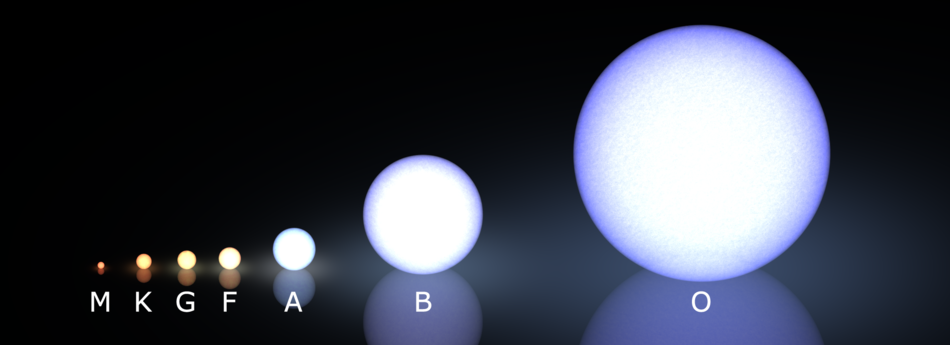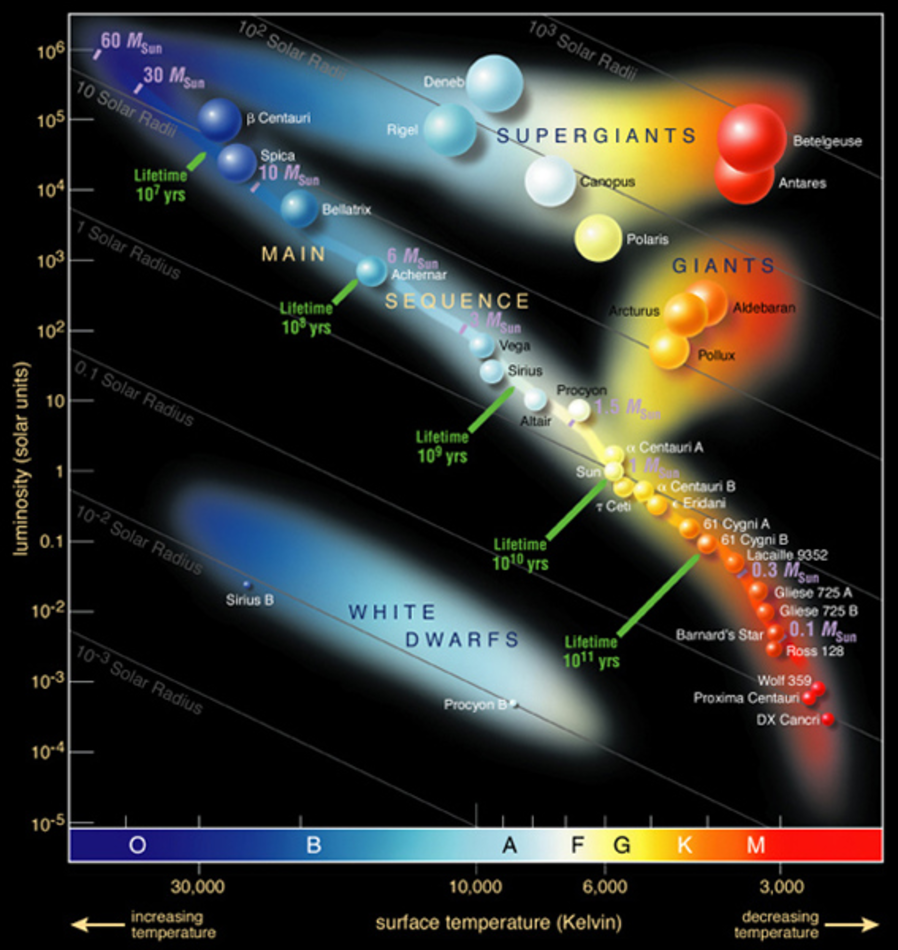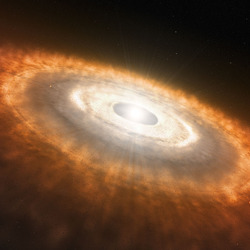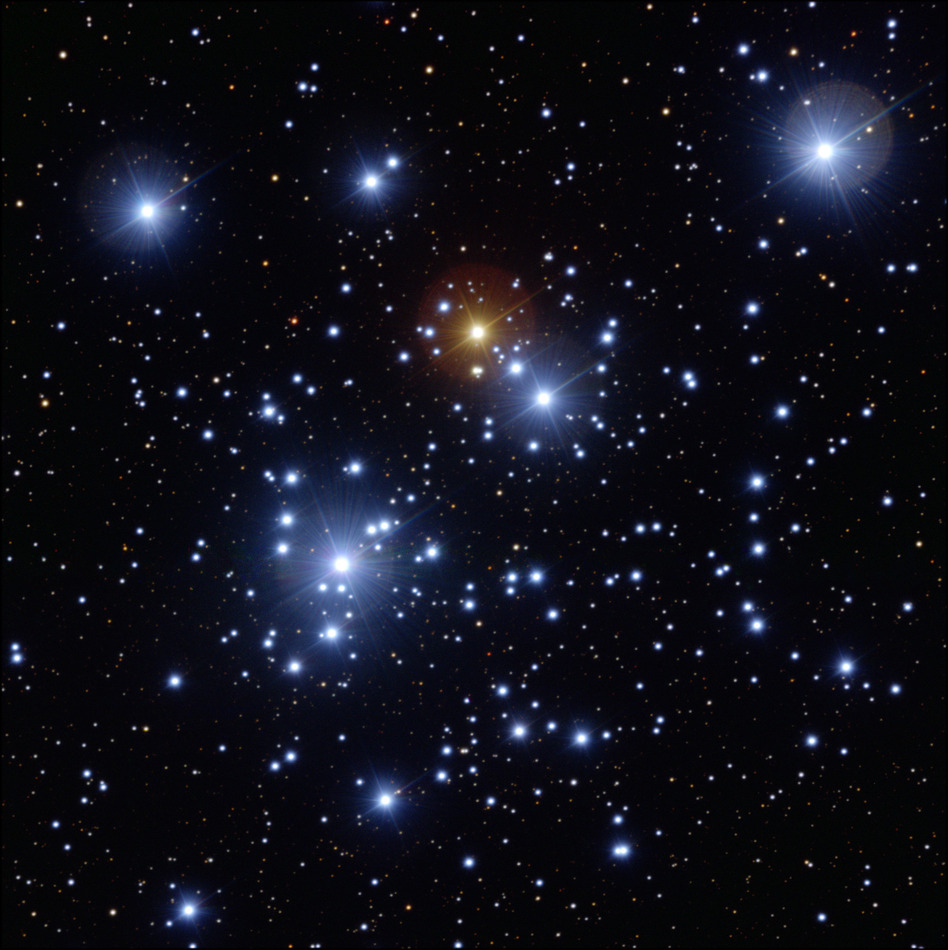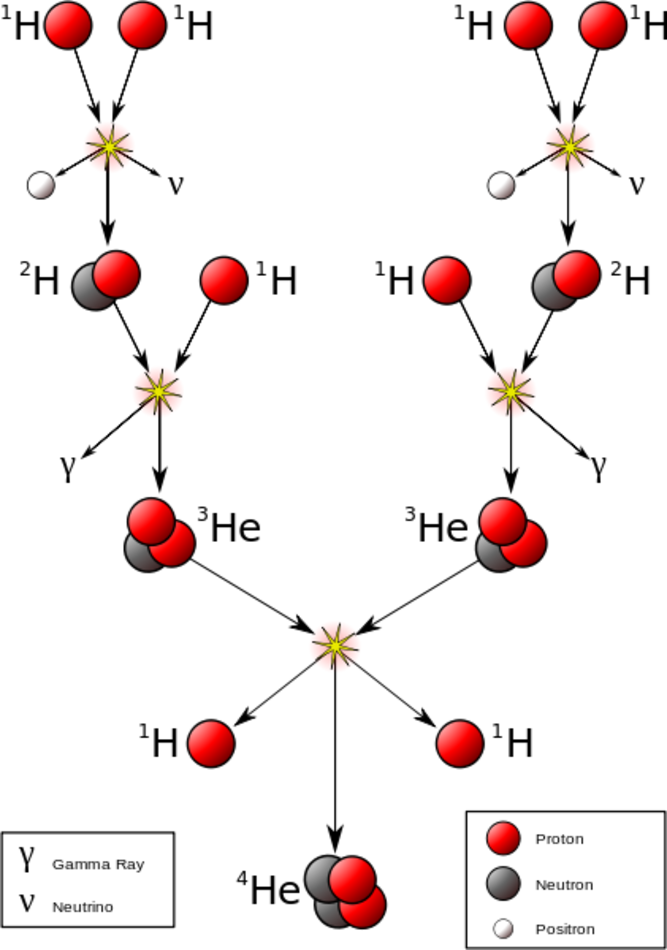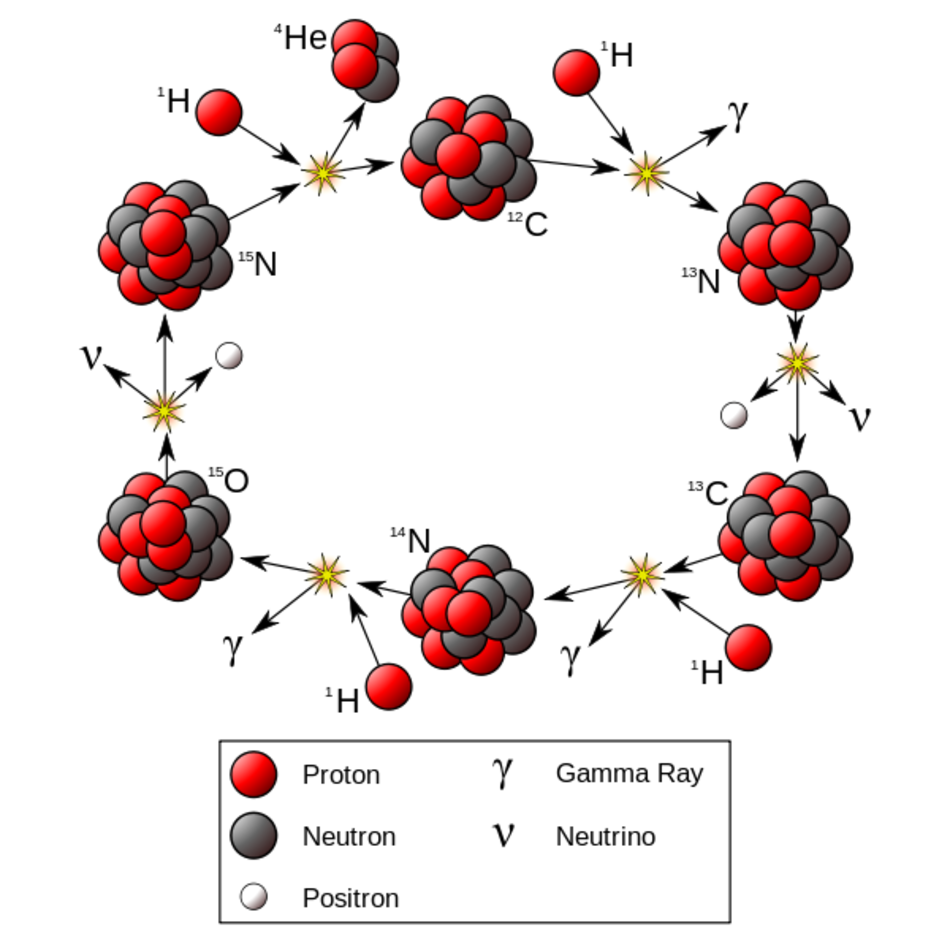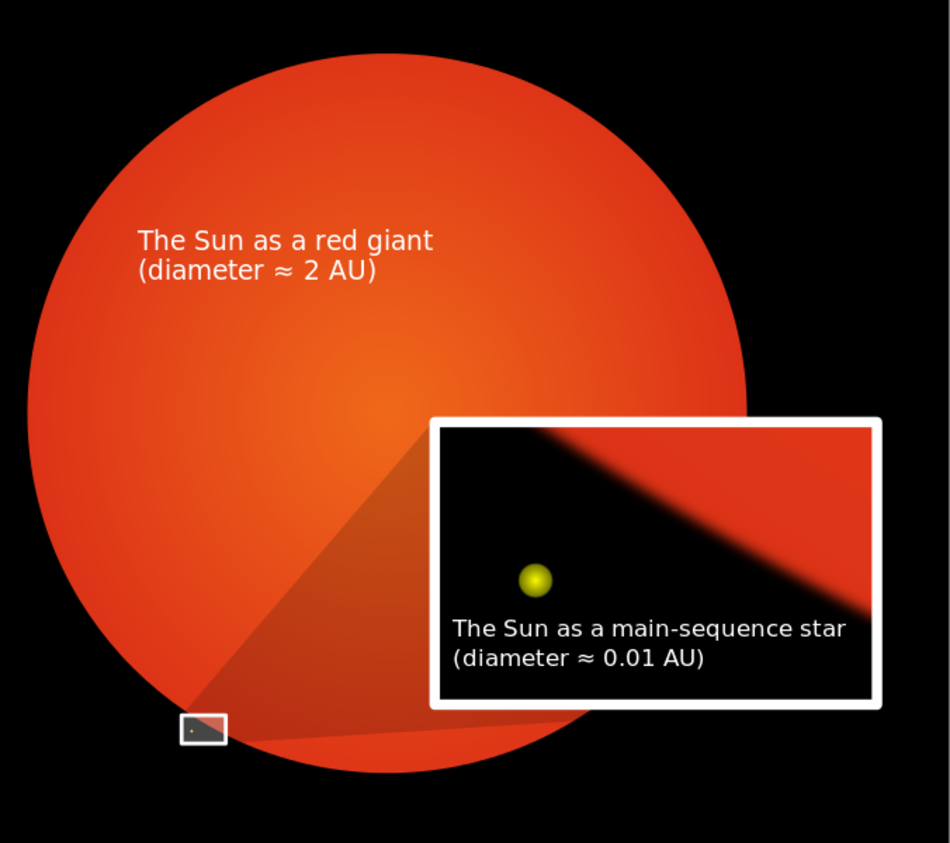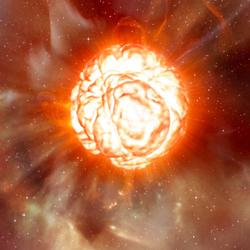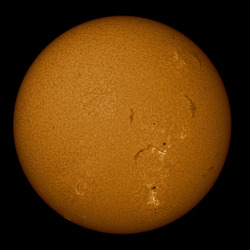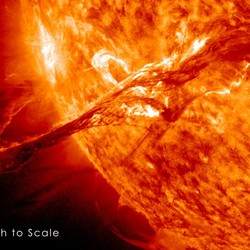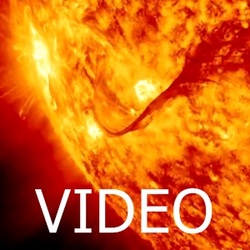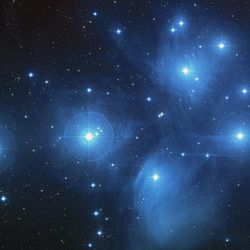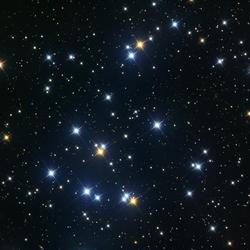
First of all, let's try to get an understanding of how many stars there are in the universe. Here is a nice analogy: let's say 80 million people come together to jointly count all the stars that exist in our known universe. They simultaneously start counting with every single person counting one star every second, so together they can manage to count 80 million stars each second. In the time you have read the text up to here (15 seconds) they have already counted a total of 1.2 billion different stars - or more than all the stars in the Small Magellanic Cloud, one of the closest galaxies to the Milky Way. The question is: for how long do these 80 million people need to continue counting until they have counted all the known stars in the universe? Try to guess... the answer can be found in the last paragraph of this article.
Contents
IntroductionClassification of stars
The formation of stars
Structure of stars
Hydrostatic equilibrium
Nuclear fusion
The death of a star
How many stars are in the universe?
Introduction
Stars are massive and luminous spheres of hot plasma. A plasma is a gas that's so hot that the nuclei and the electrons of the atoms have separated, so it's essentially a hot "soup" that contains positive ions (atom nuclei) and electrons. Stars typically consist of 70-75% hydrogen, about 25% helium and some heavier trace elements. The composition can vary significantly, mainly depending on the age of the star and whether it was born in the early times of our universe or more recently. The Sun, for example, is composed of 74.9% hydrogen and 23.8% helium, leaving less than 2% for all other elements heavier than helium. During most of their lifespan stars generate radiant energy by fusing hydrogen into helium, a process that converts mass into energy and releases energy in the form of radiation of various wavelengths. In order to maintain nuclear fusion in their cores, stars have core temperatures ranging from 4 million to 40 million degrees Kelvin.
Classification of stars
Stars come in various sizes, from the smallest and coolest, so called M-type stars, to the heaviest and hottest O-type stars. Our Sun, for example, is a G-type star, somewhere in the middle. The image below gives you an overview of the different types of stars as well as their size and the colour with which they shine.
Stars do not live forever; they can only shine for a certain amount of time. The lifetime of a star strongly depends on its mass. You might expect that more massive stars live longer since they have more fuel (hydrogen) to burn, but the opposite is true. This is because the luminosity of a star - and with it the released energy or power - approximately increases with the 3.5th power of the star's mass. A star twice as massive as the Sun has a luminosity of more than 11 times that of the Sun. Considering that this star has only twice as much fuel to burn at 11 times the released energy you can expect the lifetime of the Sun to be more than 5 times longer. On the other hand, a star with just 0.2 solar masses will live for 560 billion years and a star with just 0.1 solar masses may live for 10 trillion years, much longer than "just" the 10 billion years of life expectancy of our Sun. The most massive O-type stars shine with a power of a million times more than the power of our Sun - a fuel consumption rate that's ridiculously high. But these massive stars are most fundamental for the emergence of planets and life since they end their very short lives with a tremendous explosion called a supernova. This event distributes an enormous amount of heavier elements into the surroundings; matter which will later be "recycled" during the formation of new star systems with their planets. All the atoms that the Earth and you are made of (apart from the basic hydrogen) have been produced in stars, most of them in relatively short-living, very massive stars.
| Class | Mass (in solar masses M☉) | Surface temperature (kelvin) | Luminosity (in solar luminosity L☉) | Lifespan of the star (years) | Percentage of all stars |
| O | > 16 M☉ | 33000 K | 30000 L☉ | 11 million | 0.00003% |
| B | 2.1 - 16 M☉ | 10000 - 33000 K | 25 - 30000 L☉ | 11 million - 1 billion |
0.13% |
| A | 1.4 - 2.1 M☉ | 7500 - 10000 K | 5 - 25 L☉ | 1 billion - 2.2 billion |
0.6% |
| F | 1.04 - 1.4 M☉ | 6000 -7500 K | 1.5 - 5 L☉ | 2.2 billion - 10 billion |
3% |
| G | 0.8 - 1.04 M☉ | 5200 - 6000 K | 0.6 - 1.5 L☉ | 10 billion - 30 billion |
7.6% |
| K | 0.45 - 0.8 M☉ | 3700 - 5200 K | 0.08 - 0.6 L☉ | 30 billion - 200 billion |
12.1% |
| M | 0.075 - 0.45 M☉ | 2000 - 3700 K | 0.0001 - 0.08 L☉ | 200 billion - 10 trillion |
76.45% |
The ☉-symbol is a symbol representing the Sun, so M☉ means one times the mass of the Sun and L☉ is the luminosity of the Sun. The lowest mass M-type stars can have luminosities of just 1/10000 that of the Sun. That's why they are so hard to detect - on most images of the cosmos we just see the brighter type of stars. Stars with masses lower than about 7.5% of the Sun's mass cannot generate high enough temperatures and pressures in their cores to fuse hydrogen-1 to helium; they become substellar objects called brown dwarfs. 7.5% of the Sun's mass is roughly 75 times the mass of Jupiter, so you need to put 75 giant planets like Jupiter together in order to generate pressures and temperatures in the core of this object that are high enough to ignite hydrogen fusion. There's also a limit for the maximum mass of a star. Based on theoretical modelling it is somewhere between 150 and 200 solar masses. The most massive star that we know of is R136a1 with its 265 solar masses, a surface temperature of more than 50000 degrees Kelvin and a luminosity of 8 700 000 times that of the Sun. It's likely that stars with these masses were formed out of a merger of two or more stars. Be happy that R136a1 lives 165 000 light years away in the Tarantula Nebula of the Large Magellanic Cloud – when it ends its short life in about a million years you'd better be far away from the supernova explosion that will take place.
All the different types of stars can be displayed in a chart called the Hertzsprung-Russell Diagram.
The surface temperature is mapped along the x-axis, with the highest temperatures to the left and the luminosity is mapped along the y-axis. The diagonal grey lines show stars of equal sizes; the masses and lifetimes of stars are indicated too. This diagram gives you a very good overview of all the stars that exist in all the different phases of their lives. For now, let's just have a look at the main sequence stars - you remember, all stable stars that still have enough hydrogen in their cores to steadily fuse hydrogen to helium. The smallest stars with masses of less than 0.5 times the solar mass all appear red due to their low surface temperatures (and therefore are called red dwarfs). Their luminosity is very low and they mainly radiate in the infrared. You can read our article about black body radiation to better understand what kind of star emits what kind of radiation. More massive stars have another colour; instead of red they appear yellow (e.g. our Sun), white (e.g. Procyon with its 1.4 solar masses) and finally blue (e.g. Spica with about 10 solar masses). Luminosity increases exponentially with the mass of the star. When stars have burned all available hydrogen in their cores they leave the main sequence and become giants, or in case of very massive stars of more than 8 solar masses, supergiants. We will have a look at these stages later. Over 97% of all stars become white dwarfs in the end; dense and initially very hot stellar remnants that cool down and fade over the next billions of years. Since white dwarfs are very dense and massive they contain a tremendous amount of heat; so much heat that they will still be emitting visible light in about 1014 years; that's almost 10000 times the current age of the universe. Our Sun will become a red giant and ultimately a white dwarf too in about 5 billion years.
The ends of stars are very different too, ranging from the most violent explosions in the universe (supernova) for very massive stars to very silent endings (the star simply gets dimmer and dimmer) in the case of low-mass red dwarfs or M-type stars. But two main characteristics of all stars are still alike: they were all born in a similar manner and after that they have a steady time of fusing hydrogen into helium before they die, sooner in case of massive stars or later in case of less massive stars.
The formation of stars
Stars are born when molecular clouds - huge accumulations of gas and dust - collapse under their own gravitational attraction. The reason for this collapse might be a shock front of a nearby exploded supernova that compresses some parts of the molecular cloud initiating the process. Another possibility is that a star with strong star winds is passing through a molecular cloud and compresses parts of it. The end result in both cases is the same: some parts of the cloud get denser, the enhanced gravity in these parts of the cloud attracts more gas and dust which in turn increases the gravitational attraction. The gas of the molecular cloud has to be very cold when the process starts, just a few degrees Kelvin, otherwise the thermal pressure of the warm gas would inhibit a collapse. The collapse doesn't stop until a new star is finally born.
But fortunately not all the material of the cloud ends up in the new-born star; some material remains in a so-called proto-planetary disc; a flat disc of gas and dust that orbits around the young star. Since the original molecular cloud spins around its own axis (in fact all things in the universe seem to rotate, from the smallest asteroids and planetoids up to the biggest galaxies), it has an initial angular momentum which is preserved during the collapse (see e.g. Conservation of angular momentum). That's why the newly born star rotates about its own axis and the matter in the proto-planetary disc rotates in the same direction as the star rotates. And finally the matter of the proto-planetary disc further collapses forming the planets that orbit the star.
Stars are not born alone; the molecular clouds are so big that from a few hundred up to many thousands of stars are born together within a (cosmologically) relatively short timeframe. Some parts of the cloud collapse first, others later. The end result is an open cluster of stars that initially is kept together gravitationally but over a time span of a few hundred million years disintegrates. 4.6 billion years ago our Sun too was born in an open cluster together with many other stars. But over time the cluster disintegrated so that our Sun now orbits the centre of our Milky Way without being bound to other stars anymore.
Structure of stars
After the collapse of the molecular cloud we have a very young star and in most cases emerging planets in the proto-planetary disc. Temperatures and pressures in the core of the star are now high enough to start the fusion of hydrogen into helium. As long as there is enough hydrogen in the core of the star to keep this fusion process running we call the star a main sequence star. Only after all hydrogen in the core is used up (which takes between a few million years and many trillion years depending on the star's size) the star leaves the main sequence and its final phase begins. During the main sequence temperatures and pressures outside the core are not high enough to ignite nuclear fusion. All the energy a star emits is first released in the inner region (the core) of the star. The energy is then transported to the surface with help of two main heat transfer processes: radiation and convection.
Heat transfer by radiation happens since hot atoms (or nuclei in the case of plasma) emit electromagnetic radiation. This radiation is then absorbed or scattered by another nucleus or electron and afterwards reemitted. Even though radiation transports the energy with the speed of light, it takes about 200 000 years for the energy released in the core of our Sun to be transported to its surface. The reason is that the photon takes a "random walk" from the core to the surface of the star. Within just about 1 mm the photon is scattered (mostly by electrons) in a random direction or it is absorbed by gas particles and then reemitted in a random direction. This process also decreases the energy of the gamma ray photons produced in the core of a star to photons with much longer wavelengths (with the peak in the visible light spectrum) when they are finally emitted from the surface into space. This is good for us here on Earth, since we do not like to be bombarded by gamma rays when we walk under the clear skies.
Convection is heat transfer by hot, less dense plasma rising up to the surface, while the cooler regions of the surface in contrast sink down towards the centre of the star. It's very similar to boiling water where hot water from the bottom of the pot rises up and cooler water from the surface sinks down. This way the plasma cycles between the surface and the outer border of the radiation zone, a very efficient means of heat transfer.
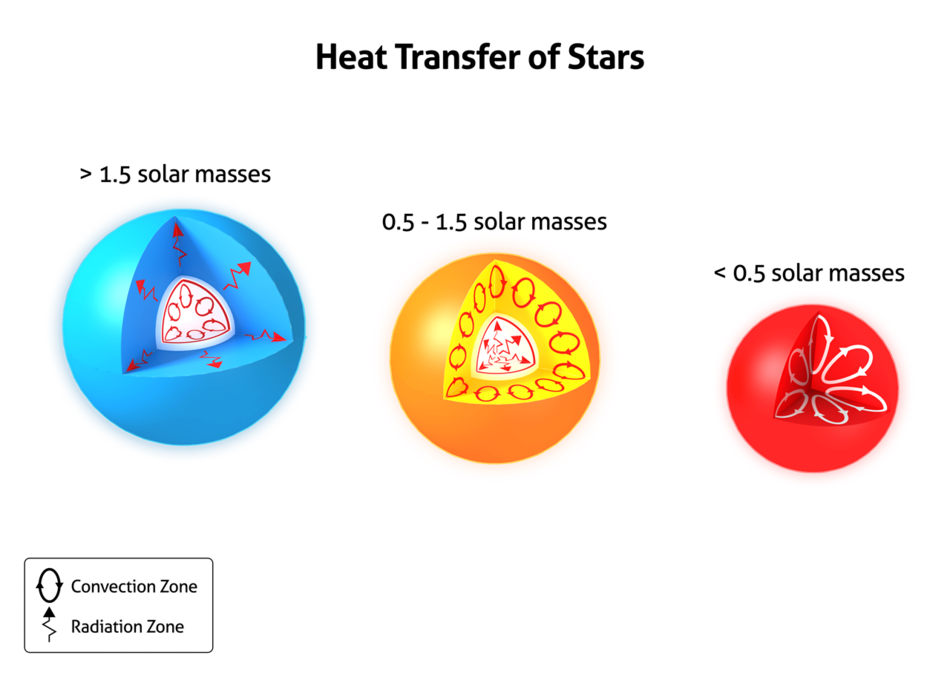 Types of heat transfer for different stars. Credit: Sun.org - www.sun.org, released under CC-BY-SA 3.0
Types of heat transfer for different stars. Credit: Sun.org - www.sun.org, released under CC-BY-SA 3.0Our Sun has an inner radiation zone reaching up to 70% of its radius and the outer 30% consists of a convective zone. Stars smaller than about 0.5 solar masses have no radiation zone; the heat transfer is completely convective. The complete mixing of matter of the outer layers and the core is a second reason why small mass stars can have lifetimes of trillions of years (as we said above the main reason is the lower fusion rate of smaller stars). In stars like our Sun almost no material is exchanged between the core and the outer layers due to the prevailing radiation heat transfer; therefore if all the hydrogen in the core is used up in about 5 billion years the Sun will approach its end despite the significant quantity of hydrogen that still exists in the outer layers of the Sun. Big stars with masses higher than 1.5 solar masses have a convective zone in their inner regions and heat transfer by radiation in the outer regions.
Hydrostatic equilibrium
Why is the energy output of main sequence stars so constant? The energy output of the Sun has had a maximum variation of just 0.1 % over the past 11 years. The reason that stars radiate with such stability is because of a phenomenon called hydrostatic equilibrium. There are two main forces that act in the Sun: a gravitational force that's directed towards the centre of the star and an outward force caused by the pressure of hot gas (thermal pressure). These two pressures almost exactly counterbalance each other at any place within the star.
Let's understand how this process works by supposing that the fusion rate in the core slightly decreases for some reason. Now the core temperature sinks and with it also the thermal pressure. Gravitational forces now outweigh the thermal pressure and cause a slight compression of the core that in turn causes a rise of the temperatures and pressures in the core again. Rising temperatures and pressures again lead to a higher fusion rate in the core; the initially decreased fusion rate is countered and again we have a stable equilibrium.
A similar process rules when the fusion rate in the core increases for some reason. This leads to a higher temperature and therewith a higher thermal pressure. The result is a slight expansion of the core which in turn slightly decreases temperatures and pressures. As a consequence, the fusion rate slightly decreases and temperatures and pressures in the core of the star are again in equilibrium. This hydrostatic equilibrium can be compared to a thermostat and lasts throughout all the time the star is on its main sequence.
Nuclear fusion
There are two main processes of energy conversion in the cores of stars. The first is called the proton-proton chain and is dominant in stars up to the size of the Sun. The second one is the Carbon-Nitrogen-Oxygen cycle (or CNO cycle) that prevails in stars more massive than 1.3 times the mass of the Sun. The fusion rate of both processes highly depends on the temperature and pressure; a small increase in temperature leads to a much higher fusion rate.
-
Proton-proton chain
The proton-proton chain (or PP chain for short) is a process that converts four protons into one helium nucleus. The process is demonstrated in the image below.
In the hot and dense cores of stars, two protons (a proton is the same as the nucleus of a hydrogen atom) sometimes crash into each other forming a very unstable element called Helium-2. Normally this element almost immediately decays back into two protons. But once in a while during the extremely short period in which Helium-2 exists one of the protons decays into a neutron, emitting a positron (the electron's antiparticle or, in other words, its antimatter counterpart) and a neutrino. This process is called beta-plus decay. Since we now have a nucleus of one proton and one neutron the result of this reaction is deuterium. The positron that arose out of the beta-plus decay almost immediately annihilates with an electron (remember that stars are composed of a plasma, so there are lots of free electrons flying around in it) creating two gamma rays. Now the deuterium fuses with another proton forming Helium-3, a light isotope of Helium. This process again releases a gamma ray that heats up the Sun's core. The Helium-3 finally fuses with another Helium-3 isotope forming a stable Helium atom or a so-called alpha particle. Two protons are released during this final step; they will have a second chance to become Helium in the PP chain.
-
The CNO cycle
At temperatures of > 15 million degrees Kelvin a much more efficient fusion reaction takes place: the CNO cycle. Like the proton-proton chain, the CNO cycle fuses four protons into one helium nucleus or alpha particle, releasing energy in the form of gamma rays. But this time carbon, nitrogen and oxygen isotopes are used as catalysts. The diagram above shows the process: 12C is used as the starting point of a chain of reactions of which 12C is also the end product. The superscripted number in front of the symbol of the chemical element indicates the atomic mass number, the total number of protons and neutrons in an atomic nucleus. Initially 12C fuses with a proton to form 13N. Now one proton of the 13N isotope decays into a positron and a neutrino (again a beta-plus decay) leaving a heavier carbon isotope 13C behind which again fuses with one proton to form 14N. 14N fuses with a proton to form 15O and after another beta-plus decay we are left with 15N that finally reacts with one more proton to form an alpha particle and leave 12C behind, the starting product of the whole chain. Three gamma rays are released in one chain cycle plus two more when the two positrons that were released during the two beta-plus decays annihilate with two ambient electrons. On average a whole cycle takes a long time to be completed, in the order of hundreds of millions of years. But this is still much less than the average time needed to fuse two hydrogen atoms into helium via the proton-proton chain.
The death of a star
For all stars there will come a certain day when all the hydrogen available for fusion has been used up. That's the day where the star leaves the main sequence branch of the Hertzsprung-Russell diagram. The further development depends on the mass of the star, so let's look at them separately:
-
0.075 to 0.5 solar masses (red dwarfs)
There is as yet no red dwarf in the universe that has already burned all its fuel. This is because the lifespan of such a star in the main sequence is much longer than the age of the universe (13.7 billion years). The small stars will begin to leave their main sequence in about 30 billion years from now at the earliest, so there is, as yet, no observational data available on how these stars evolve. But the future development of red dwarfs is not completely unknown since scientific modelling can reveal many details. After all their hydrogen is used up nuclear fusion will terminate, thermal pressure in the core will decrease and as a consequence the star will contract. This increases the core temperature again since gravitational energy will be converted into thermal energy. However the masses of red dwarfs are not great enough to generate temperatures allowing helium to fuse into heavier elements. The star will slowly cool down and contract and its luminosity will decrease until one day it will vanish from the visible spectrum of the night sky. Thus these stars end with a whimper rather than a bang.
-
0.5 to 8 solar masses
Stars in this mass range will undergo a very different development. Let's observe our Sun's destiny as an example of stars with these kinds of mid-masses. After all the Sun's hydrogen in the core has been fused into helium, heat production in the Sun will come to a halt. This will be the first time in 10 billion years that the equilibrium will be out of balance (by the way: if you want to know how we could (at least theoretically) extend the life of our Sun just check our Q&A section). With less thermal pressure to counteract against gravity, the helium core will start shrinking and potential energy will be converted into heat (Kelvin-Helmholtz heating). In falling, fresh hydrogen from layers outside the core will ignite hydrogen fusion in a shell surrounding the core, further heating up the Sun. As a consequence temperatures will increase so much that the star’s luminosity will become hundreds of times greater than before.
The increased temperatures lead to an expansion of the Sun (remember: hot gas always expands if there is no counteracting outside pressure) which in turn will lower the surface temperatures. The Sun will now have become a red giant and its diameter will be 100 times its original diameter. In the case of the Sun all of this will happen in about 5.4 billion years. You can actually see this development in the "GIANTS" area of the general Hertzsprung-Russell diagram: the luminosity increases and, due to the much greater surface area of the Sun, its surface temperature decreases. The Sun now emits its radiation mainly in the red part of the visible light spectrum - that's why these stars are called red giants. The Sun will remain in the red giant branch phase for about 1 billion years. The following extract of the Hertzsprung-Russell diagram shows the development path for the Sun.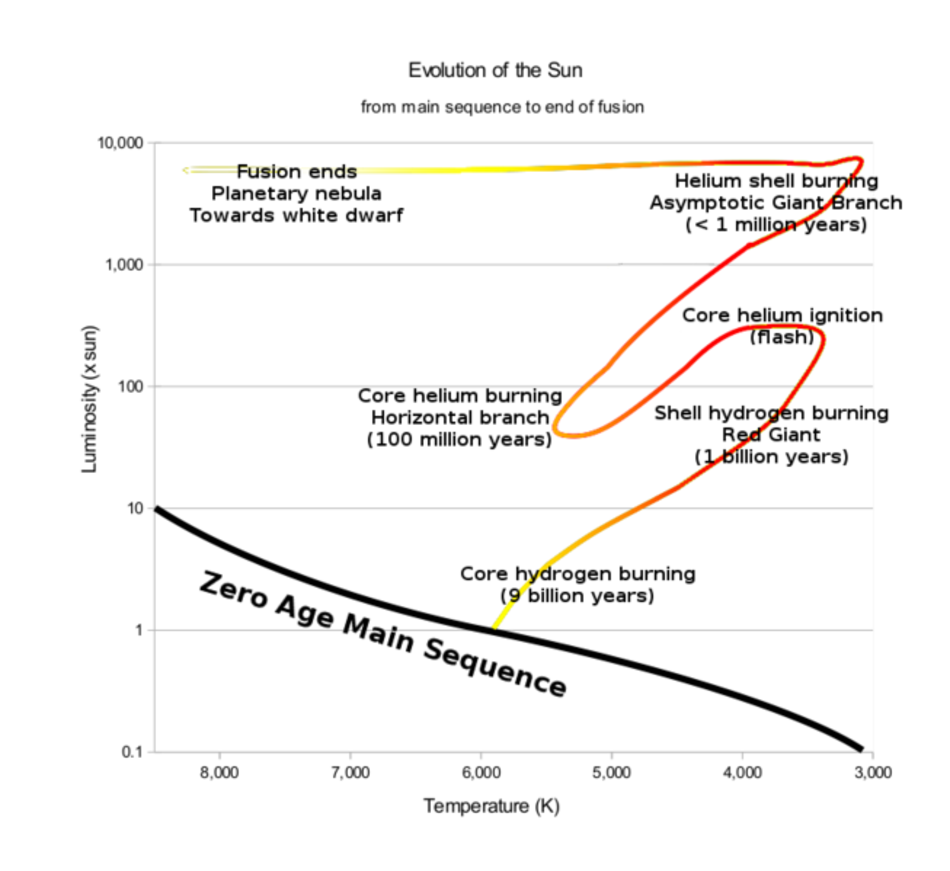 Evolution of a Sun-like star in the Hertzsprung-Russell diagram. Source Wikipedia.org, user: Lithopsian
Evolution of a Sun-like star in the Hertzsprung-Russell diagram. Source Wikipedia.org, user: LithopsianNow the pressure in the core gets so high that the electron degeneracy pressure prevents a further collapse of the core. This degeneracy pressure is independent of temperature, so an increase in temperature will not be followed by an increase in pressure as is the case for normal matter. This means that there is no possibility of the star expanding and consequentially decreasing the temperature and pressure in its core as is the case for a star in main sequence (see hydrostatic equilibrium). Due to the hydrogen fusion in the shell around the inert helium core, its temperature continues to increase until it reaches about 100 000 000 kelvin. This is the temperature required to fuse helium into carbon and oxygen via a process called the triple-alpha process. Since the core is degenerate it cannot expand in order to slow down the fusion rate; on the contrary the energy release during helium fusion will further heat up the core. The result is an event called a helium flash: all of a sudden all the helium atoms in the core fuse to carbon almost at the same time. This happens to all stars of between 0.5 and 2.25 solar masses, so it'll happen to our Sun too. All heavier stars will reach the 100 000 000 kelvin required for fusing helium atoms before their cores get dense enough to be degenerate. In these cases the helium fusion process starts smoothly, hence we have no helium flash.
The helium flash only lasts a few seconds during which the energy output of the star is 100 billion times greater than normal. Surprisingly we cannot observe the helium flash directly despite the enormous energy released because it only happens in a small region in the core of the star and the released radiation is absorbed by the core and its surrounding atmosphere. The helium flash changes the state of matter in the core and degenerate matter again becomes non-degenerate since temperatures get so high that thermal pressure outweighs degeneracy.
After the helium flash the core expands, leading to a lower pressure and temperature and consequently a lower fusion rate in the core and the surrounding shells. The lower energy production in the core leads to a smaller diameter (about 10% of the diameter of a Red Giant) and the Sun's luminosity decreases over a period of 100 000 years to about one hundredth of the previous maximum value. You can observe this process well in the Hertzsprung-Russell diagram following the line from "Core helium ignition (flash)" to "Core helium burning".
But the death of a star is a dynamic environment: the shrinking of the star consequently heats the star up again (remember, the potential energy will be converted to thermal energy when two masses approach each other). The carbon-oxygen core is now surrounded by a shell where helium undergoes fusion to carbon and another hydrogen-to-helium fusion shell. The outer layers of the star are composed of hydrogen that is not hot and dense enough to fuse into helium. Again, the star is now in a hydrostatic equilibrium, but since the core temperature is now 200 million kelvin the processes run much faster. In the case of the Sun, helium burning to carbon in the core will continue for "just" about 100 million years. Some of the carbon that is generated will fuse with another helium core to form oxygen and a very tiny fraction of the oxygen fuses with other helium cores to form neon and magnesium.
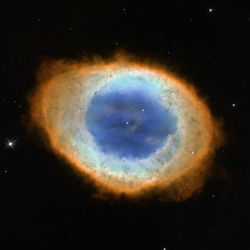 The Ring Nebula - a planetary nebula
The Ring Nebula - a planetary nebula Then, finally, all the helium in the core is exhausted and a process starts that's very similar to the one we observed before when hydrogen was exhausted. We're now in the asymptotic giant branch (AGB) phase and things go much faster: the core shrinks, the temperature and pressure rise, infalling helium from regions outside the core heats up so that helium shell burning occurs and the Sun will increase in size and luminosity again (see the line between "Core helium burning" and "Helium shell burning" in the Hertzsprung-Russell diagram). This time it'll increase in size to even larger than before - it will engulf Mercury, Venus and maybe even Earth. It won't make a big difference for Earth whether or not it will be engulfed... if the Earth is engulfed it will be slowed down by the Sun's atmosphere and start spiralling down towards the centre of the Sun. In the second case Earth will be so close to the Sun that it will be cooked and baked; nothing will ever be able to survive these temperatures. Anyhow, the temperature in the Sun's core will not get high enough to start a new cycle of carbon fusion to heavier elements (we need about 1 billion kelvin in order to ignite carbon fusion). From now on the core will be inert and helium and hydrogen burning will occur in the shells outside the core.
Due to the huge size of the red giant, part of the gas of the star is now so far away from its core that this part of the gas is only loosely gravitationally bound to the star. The star that has already lost 10-20% of its mass during the red giant phase loses another 20-30% during the asymptotic giant phase. This mass, which is almost entirely pristine hydrogen gas, will be ejected into the surrounding space and a planetary nebula is born. Don't get confused by the misleading name planetary nebula; it's a remnant of former times when William Herschel observing these objects found similarities to the appearance of Uranus, therefore giving it this name. The name has not changed since those times despite the fact that we now know that these nebulae have nothing to do with planets at all. A nice example of such a mass-losing star is the Ring Nebula. The "life expectance" of such a planetary nebula is quite short; after about 50000 years the matter that once formed the planetary nebula has been distributed into outer space and is ready to become part of another star system in the far future.
After a few tens of thousands years all the material in the shells has also been fused and the whole star becomes inert. What will be left in the case of the Sun is a burnt out carbon/oxygen core of 0.6 solar masses and a size of approximately the Earth. The density of the core - which is now called a white dwarf - is very high; a teaspoon of this matter weighs one ton. Initially the white dwarf is still very hot and bright, but over time it cools off and gets dimmer and dimmer. It'll take a very long time for white dwarfs to cool down; the coolest observed white dwarfs still have surface temperatures of a few thousand kelvin. The final stage of the stellar evolution will be achieved in many trillion years when the Sun will have cooled down to a temperature at which it is in thermal equilibrium with the surrounding universe (or in other words: the cosmic background radiation), barely above 0 kelvin.
-
above 8 solar masses
Here things get really interesting. You should read our supernova article.
